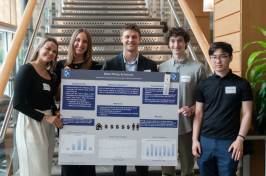
A new study by Matt MacManes, assistant professor in the Department of Molecular, Cellular and Biomedical Sciences, points to the importance of studying both males and females in experimental biology.
At their core, the findings of recent research led by Matt MacManes seem obvious: Males and females are different. Yet the work disrupts a long-held gender bias within experimental science.

For decades, scientists have used mostly males as animal study subjects, assuming that, unless they’re specifically exploring reproduction or sexual behavior, males and females are basically the same. MacManes’s study, published recently in the journal Scientific Reports, found large differences in tissue gene expression between male and female rock doves (Columba livia), or common pigeons, even though they weren’t engaged in reproduction.
“We were surprised there were so many sex-specific differences, says MacManes, who is an assistant professor in the department of molecular, cellular and biomedical sciences. “The vast majority of our foundational knowledge has been based on the study of a single sex, and here we are, finding all sorts of interesting differences. That was the exciting thing about this paper.”
MacManes and his collaborators, including UNH Ph.D. student Andrew Lang and Rebecca Calisi of the University of California at Davis, analyzed tissues of the reproductive systems of the pigeons: the hypothalamus-pituitary-gonad, or HPG, axis shared by animals from fish to birds to mammals.
In the pituitary, especially, the researchers found far more differences between males and females in gene expression than expected. Gene expression is the link between the genotype — the genetic makeup of an organism — and the phenotype, an organism’s appearance and behavior.
“There are two sexes. Knowing something about both of them has to deepen our understanding of biological phenomena.”
“We thought that these brain regions in particular would look pretty much the same in non-reproductive birds. What surprised us was the magnitude of these differences,” MacManes says.
The findings have impact beyond genetics, as scientific fields works to become more gender-inclusive. “There's a problem of sex and gender inclusion at all levels of science from faculty to the animals we use,” Calisi says. That’s changing, thanks in part to studies like this one and others before it; the National Institutes of Health, for instance, now mandates that studies be conducted on both males and females.
“There are two sexes. Knowing something about both of them has to deepen our understanding of biological phenomena,” MacManes says. Reliance on males has been largely out of convenience, he notes. “Our study illustrates that it’s worth studying both.”
MacManes adds that this study, which paired his expertise in genetics with Calisi’s in neuroendocrinology, also points to the importance of interdisciplinary research. “Each of us alone would have never been able to do this type of study,” he says. “Integrating across disciplines makes for really cool work that wouldn’t be possible otherwise.”
This work is part of a larger study that aims to understand changes in the brain during parental care, as the rock doves progress from non-breeding adulthood through fledging their chicks. It is funded by the National Science Foundation, Division of Integrative Organismal Systems, award number 1455960.
-
Written By:
Beth Potier | UNH Marketing | beth.potier@unh.edu | 2-1566

















































